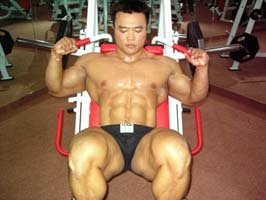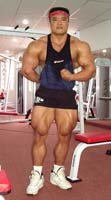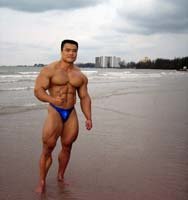It may sound unbelievable, and might even defy conventional bodybuilding wisdom, but IFBB pro bodybuilder Wong Hong does not perform barbell squats, and, yet, has some of the most insane leg development ever seen. Does this sound unlikely? Check out the accompanying pictures and judge for yourself.
Indeed, Malaysian born Wong is clearly gifted in the legs department, although the rest of his physique is in near-perfect balance with these massive appendages. Possessor of possibly the largest vastus medialis (the tear-drop muscle near the knee) in pro bodybuilding today, Wong believes in machines over free weights to build mass and etch detail in the entire leg musculature.
Although Wong has never performed the "traditional" mass builders, he believes one can achieve massive legs with smart training, as opposed to power-training with the heaviest possible weights. High-volume training sessions, which combine compound and isolation movements, and emphasize strict form, provide the perfect environment for continued gains in leg mass for Wong.
Wong feels the legs are the most important muscles for a bodybuilder to develop as they can be seem from all angles (in all seven compulsory poses).
He urges those wanting competitive success in bodybuilding to never neglect their legs. Wong's own legs were built with years of hard work, and were not, as one might be led to believe (based on his bias for machines) easy for him to develop. However, with determination, and smart training, Wong has accomplished a set of legs that will again rock the pro stage very soon. Keep an eye out for Wong in 2006.

[ Q ] Wong. Were your legs always genetically strong, or have you had to work hard to develop them over many years?
A:
- I used to have skinny legs before I took up bodybuilding. I had to put in a lot of effort over the years to bring them up.

[ Q ] What leg training approach has worked best for you?
A:
- My legs respond best to two times training a week with heavy weights, four sets of 8-12 reps in each exercise. Total sets including hamstrings are around 35.

[ Q ] Machines or free weights: what are best for leg training in your view?
A:
- I prefer machines over free weights. Leg presses and hack squats are excellent for building mass, and leg extensions and Smith machine lunges are good for definition and cuts.

[ Q ] What? No regular barbell squats?
A:
- The reason why I am not a big believer in traditional squat with the barbell is because I feel the stress from this movement more on my lower back, than on my thighs.
I have tried doing it with heavy and light weights, but still experience the same thing—lower back soreness. I have a small waist, so I guess squats with a barbell are not the exercise for me.
I did some squats during my first few years in bodybuilding but even then I was not a big believer in this exercise.

[ Q ] What then, in your opinion, is the best overall leg-mass builder, and why?
A:
- The vertical leg press, because you are going against gravity, your back is protected and no upper body strength is utilized. In other words, when performing this exercise, you are fully using your legs to push the weights. This exercise targets legs and only the legs.

[ Q ] How did you achieve such a good balance between your quads, hamstrings and calves?
A:
- Trying out different exercises over the years and choosing the ones that work best for me. These are the must-have exercises in every leg workout and every now and then I would throw in some new exercises to shock my legs into new growth. I can say I have done every leg exercises known out there!
Also, I always vary my floor positioning when performing an exercise. For example, hack squats are used to hit different areas of the quadriceps. I train smart. That means, when I see a part that is lagging (i.e.: hamstrings, outer or inner thighs), I would put in more work to bring it up so that it is in balance with the rest of my leg development.

[ Q ] Describe your current leg training routine (sets, reps, training split and exercises).
A:
Quadriceps:
- Leg Extension 2 X 40 (as warm-up)
- Leg Press 4 X 8-12, up to 1,300 lbs
- Hack Squats 4 X 8-12, up to 550lbs
- Leg Extension 4 X 8-12, up to 180 lbs Walking Lunges 3 X 50 feet with 40lbs dumbbells
Hamstrings:
- Lying Leg Curls 4 X 8-12, up to 140 lbs
- Seated Leg Curl 4 X 8-12, 120 lbs
- Standing Leg Curl 4 X 8-12, 80lbs
- Stiff-leg Deadlift 4 X 8-12, with 8- lbs dumbbells

[ Q ] When designing a leg training routine, what are the main points to be considered?
A:
- A good leg training program should consist of
compound
- and
isolation
- exercises. Legs are a big muscle group, so doing high volume (not less than 30 total sets for quads and hams) is important to hit different areas of the legs for complete development.
Quads:
- For quadriceps, three to four compound movements such as:
- Leg Press
- Hack Squat
- Squats
- Front Squats for mass
And one to two isolation movements like:
- Leg Extensions for definition.
Knees:
- Warm-up your knees with leg extensions (30-40 reps with very light weights), then perform a compound movement before going back to leg extensions - again (3-4 sets) for the final burn.
Hamstrings:
- For hamstrings, the stiff-leg deadlift is a must, as this is the meat and potato exercise for mass, shape and details.
Other hamstring exercises are:
- Lying Leg Curls
- Standing Leg Curls
- Seated Leg Curls.
All exercises should be performed in good form (no jerking or bouncing) and be sure to stretch between sets.
| Main Muscle Groups Worked By Exercises. | ||
|
|
||
|

[ Q ] What improvements/alterations have you made to your legs program over the years?
A:
- I have been doing lots of Smith Machine front squats over the past two-years. As a result of that, I have brought up my front thighs. At one point in my bodybuilding career, my hamstrings were lagging, so I emphasized stiff-leg deadlift which is important for mass and detail.

[ Q ] Are their any improvements to be made to your legs? If so, what plan do you have?
A:
- I think my leg development is good in terms of shape, balance, definition, and size, but I still need to bring up my calves mass especially the outer calves to match my upper legs. I will be doing lots of seated calf raises and donkey calf raises for overall calf mass.

[ Q ] What rep ranges are best for legs? High reps or low reps? Why?
A:
- Eight to twelve reps work best for me regardless of the types of exercises. If performed in good form, this rep range is the best for mass and definition too.
I stick to this rep range even when I am preparing for a show. If I go too low in reps, I do not feel a good pump and if I go too high, my legs tend to lose too much mass - especially during pre contest time.

[ Q ] Many people struggle to develop their calves. What are the best strategies for calf development?
A:
- Train calves three times a week and do it at the beginning of your workout when you are fresh and have plenty of energy.
Seated calf raises for outer calves, donkey and standing calf raises for overall mass and front calf raises for the tibia muscles. Aim for a full range of motion, hold a second or two at the top and stretch the calves between sets.

[ Q ] What advice would you give a beginner who wants to build their legs to a respectable size?
A:
- Beginners should be able to build their legs to a respectable size by doing:
- Squats
- Leg press
- And/or hack squats
Four sets each with 8-12 reps. Go as heavy as possible but in good form.
For hams, do:
- Stiff-leg deadlift
- Lying leg curls
Again four sets each with 8-12 reps. Again, aim for a full range of motion, feel each rep and stretch in between sets. For hard gainers, train legs twice a week.

[ Q ] In your view, why are legs important from a bodybuilding standpoint? Why are they important in a functional sense?
A:
- Legs are the most important muscles in competitive bodybuilding. This is because they are clearly visible in all of the seven compulsory poses come competition time. From front double bicep to abdominal and thighs, one cannot hide his/her weakness in leg development from the judges.
From a functional standpoint, strong legs developed from strength training help stabilize the joints of the lower body. This is important for people who are weak and have terrible balance i.e. elderly.

[ Q ] Provide five of your favorite leg training tips Wong?
A:
- Try to work every angle with variety of leg exercises for complete leg development.
- The best approach is four sets of 8-12 in each exercise for mass and definition.
- Every now and then, perform single leg movements to better concentrate the emphasis on each limb and increase the intensity of training (perform non stop one leg after another for advanced athletes).
- Always stretch your quads and hams in between sets for faster recovery. Also, stretching elongates the muscle tissues and thus this is important for competitive bodybuilders because the transformation between the flexed and un-flexed muscles is more dramatic (muscles pop out when flexed!!).
- Do lunges at least every second week as this is the best exercise for the glutes/hams tie ins. Glutes/hams tie-ins is almost a must in today's standard of competitive bodybuilding.

[ Q ] Thank you Wong for your great insights. These will help a lot of people.
A:
- My pleasure David. Thank you for the interview.




